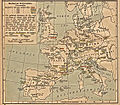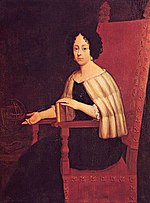Search results
Appearance
There is a page named "University of Padua" on Wikipedia
- The University of Padua (Italian: Università degli Studi di Padova, UNIPD) is an Italian public research university in Padua, Italy. It was founded in...27 KB (2,902 words) - 10:35, 22 April 2024
- by Giotto at the beginning of 1300. Padua is home to one of the oldest universities in the world, the University of Padua, founded in 1222 and where figures...70 KB (7,878 words) - 11:52, 1 July 2024
- studied medicine at the University of Padua and later went to the University of Paris, where he became a devoted admirer of Aristotle, whom he called...12 KB (1,435 words) - 15:54, 2 June 2024
- Nicolaus Copernicus (category University of Padua alumni)by Canon Bernhard Sculteti. This time he studied at the University of Padua, famous as a seat of medical learning, and—except for a brief visit to Ferrara...157 KB (18,126 words) - 05:20, 25 June 2024
- Anthony of Padua, OFM, (Portuguese: António/Antônio de Pádua; Italian: Antonio di/da Padova; Latin: Antonius Patavinus) or Anthony of Lisbon (Portuguese:...44 KB (4,751 words) - 17:14, 22 June 2024
- This is the list of universities in Italy, sorted in ascending order by the name of the city where they are situated. Source: MIUR, Anagrafe Nazionale...44 KB (1,636 words) - 19:54, 18 April 2024
- main universities of Europe: all would have been based on the Paduan archetype. It is the symbol of a successful period in the University of Padua's history...16 KB (1,763 words) - 03:07, 20 June 2023
- regions of Europe. Students in the University of Padua were divided into 22 nations, which referred to the different territories ruled by the Republic of Venice...18 KB (1,950 words) - 10:13, 24 June 2024
- Spanish). University of Salamanca. Archived from the original on 11 September 2017. Retrieved 30 January 2017. "History". University of Padua. Archived...167 KB (6,357 words) - 22:43, 1 July 2024
- Filippo Berto (category Academic staff of the University of Padua)Industrial Engineering from the University of Padua. After that, he completed his Ph.D. in Mechanical Engineering at the University of Florence, in 2006.[citation...21 KB (1,799 words) - 20:01, 2 July 2024
- Elena Cornaro Piscopia (category University of Padua alumni)her tutor in philosophy and at that point, the Chairman of Philosophy at the University of Padua, published a book in 1668 written in Latin and centred...22 KB (2,215 words) - 05:44, 14 June 2024
- Natural light of reason)care of his younger brother Michelagnolo. In 1592, he moved to the University of Padua where he taught geometry, mechanics, and astronomy until 1610. During...130 KB (15,897 words) - 19:53, 26 June 2024
- Botanical Garden of Padua)is still in its original location. The garden – operated by the University of Padua and owned by the Italian government – encompasses roughly 22,000...12 KB (1,416 words) - 18:16, 28 April 2024Pietro Perona (category University of Padua alumni)director of the Caltech Computational Vision Group. Perona obtained his D.Eng. in electrical engineering cum laude from the University of Padua in 1985...9 KB (658 words) - 00:10, 28 January 2024Padua Cathedral, or Basilica Cathedral of Saint Mary of the Assumption (Italian: Duomo di Padova; Basilica Cattedrale di Santa Maria Assunta), is a Catholic...12 KB (1,556 words) - 00:34, 8 April 2023(category University of Padua alumni)Zan is a member of the Italian Parliament, and an LGBTQIA+ activist. He graduated in telecommunications engineering at University of Padua, and Alessandro...4 KB (373 words) - 20:11, 26 June 2024
- Later he was a professor of grammar and rhetoric at the University of Padua and a notary for the city's commune. A supporter of the communal freedom, he...1 KB (154 words) - 13:26, 12 January 2023
- Gabriele Falloppio (category Academic staff of the University of Padua)the chair of anatomy at the University of Pisa. In 1551, he was invited to occupy the chair of anatomy and surgery at the University of Padua and also...11 KB (1,348 words) - 02:41, 6 May 2024
- (1913) University of Padua by Umberto Benigni 104882Catholic Encyclopedia (1913) — University of PaduaUmberto Benigni The University of Padua dates, according
- The University of Padua (Italian: Università degli Studi di Padova, UNIPD) is an Italian public research university in Padua, Italy. It was founded in
- Italian peninsula dominated the world because of its position in the Mediterranean Sea. Universities in Padua, Rome, and elsewhere taught men from East and












